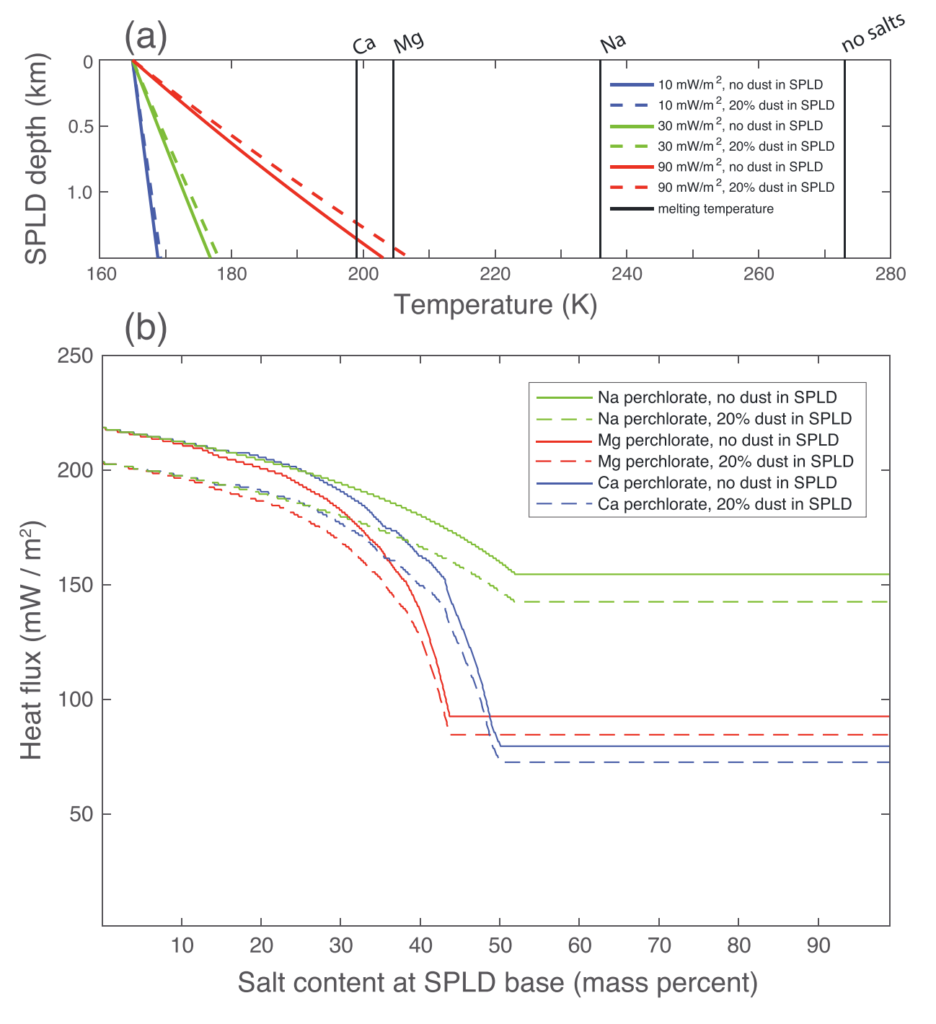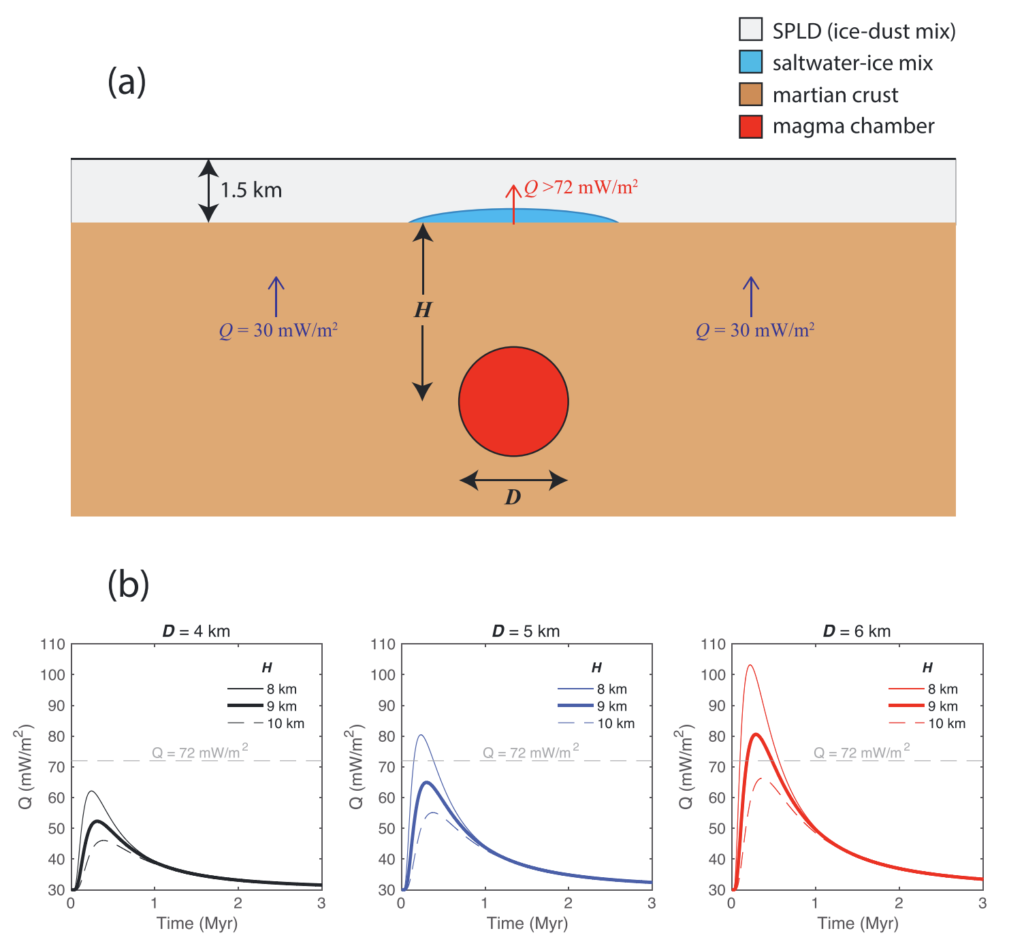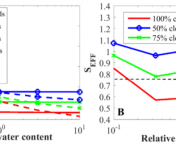Authors: Michael Sori and Ali Bramson
First Author’s Institution: Lunar and Planetary Laboratory, University of Arizona
Status: Published in Geophysical Research Letters, closed access
For years now it has been widely held that Mars had an abundance of liquid water in its early history that some scientists believe was removed through an extreme global warming scenario. In 2017 the Mars Reconnaissance Orbiter found evidence of water ice deposits under the poles of Mars. Then in 2018 the Mars Express spacecraft found, using radar, evidence of liquid deep under the ice. Liquid water requires high pressures and temperatures, not believed to be possible on Mars currently, which led the authors of this paper to hypothesize that heating deep under the Martian south pole is responsible for melting the ice.
Turn up the Heat
Dissolving salts in water will lower the melting point, which is why putting salt on a frozen sidewalk melts the ice. While Mars’ surface temperature of 162 K (-111°C) is too cold to melt pure ice, salty ice would melt more easily. The authors propose that the ice under the south pole is quite salty and heated from underneath by a yet undiscovered mechanism, creating a small pool of liquid water.
To test their hypothesis, they ran simulations of thermal conduction underneath the south pole ice cap, modeling how each layer of Mars transmits heat toward the surface. These models considered different concentrations of each salt and concentrations of dust within the ice. The goal of these simulations was first to determine how much heating would be required to melt the ice caps and then determine what might cause that kind of heating.

Figure 1a shows the temperature of the ice versus depth for different heat flow values (Q) and for different dust compositions. The vertical lines are the melting point for each type of salt, showing that the only situation where the ice gets warm enough to melt at 1.5 km below the surface is Q = 90 mW/m2 and dissolved Calcium or Magnesium salts. Figure 1b shows the heat flow (Q) required to melt the ice depending on the concentration of salt, which shows that salt concentrations above 55% do not further affect the necessary heat flow.
Too Hot to Handle?
The authors found after running their models that the lowest amount of heat flow required under the most favorable conditions is Q = 72 mW/m2. For reference, Mars has an average global heating of Q = 19 mW/m2 and a maximum of Q = 25 mW/m2, so it is hard to produce a heating nearly three times higher. On earth there have been observations of heating greater than 200 mW/m2 under Antarctica but that is caused by Earth’s tectonic activity while Mars is tectonically inactive. That leaves the authors to theorize the magma flows under the south pole are the only possible mechanism for melting the ice.
The authors propose a magma chamber shown in figure 2a, which would be a small pocket of magma located just under the south pole. Figure 2b shows the heating from magma chambers of different depths and sizes, indicating that a magma chamber 8 km deep and 5 km wide that formed about 300,000 years ago could cause a heating of 72 mW/m2 today and melt the south pole ice cap.

Theory on Mars geological history states that lava flows were quite common billions of years ago but are not found today. There is some crater evidence of magma pockets that existed as recently as 5 million years ago but the authors acknowledge uncertainty about those results.
Unexpected or Unreasonable?
The authors conclude that salty ice would have been able to melt into the water observed by radar if a magma chamber had formed under the south pole ice cap a few hundred thousand years ago. They add that there are two possible alternatives to explain these results.
The first is that their models were incomplete or made incorrect assumptions. Models can always be designed to use more computing power or consider more variables, but the authors found that adding more terms to their equation of heat conduction hardly changes the results. Furthermore, they conclude that the difference between the maximum natural heat flow of Q = 25 mW/m2 and the minimum necessary heat flow of Q = 72 mW/m2 is too large to be explained by modeling errors.
The second possibility is an incorrect interpretation of radar data. The radar identified a region under the south pole where the electric permittivity is high, meaning something is conducting electricity better than expected. Water is the most likely natural cause of high permittivity but it is possible other minerals located there could cause the same permittivity; it is just not yet known what those minerals might be.
The paper concludes that even though magmatic flows 1.5 km below the Martian south pole ice cap 300,000 years ago is unlikely under current Mars geological theory, it is still the best theory to explain the water detected by Mars Express. If they are correct it would represent a major shift in theory on Mars magmatism and geology. Regardless, the authors encourage further radar analysis and follow-up modeling of this phenomenon.
Cover image credit: NASA Solar System Treks




